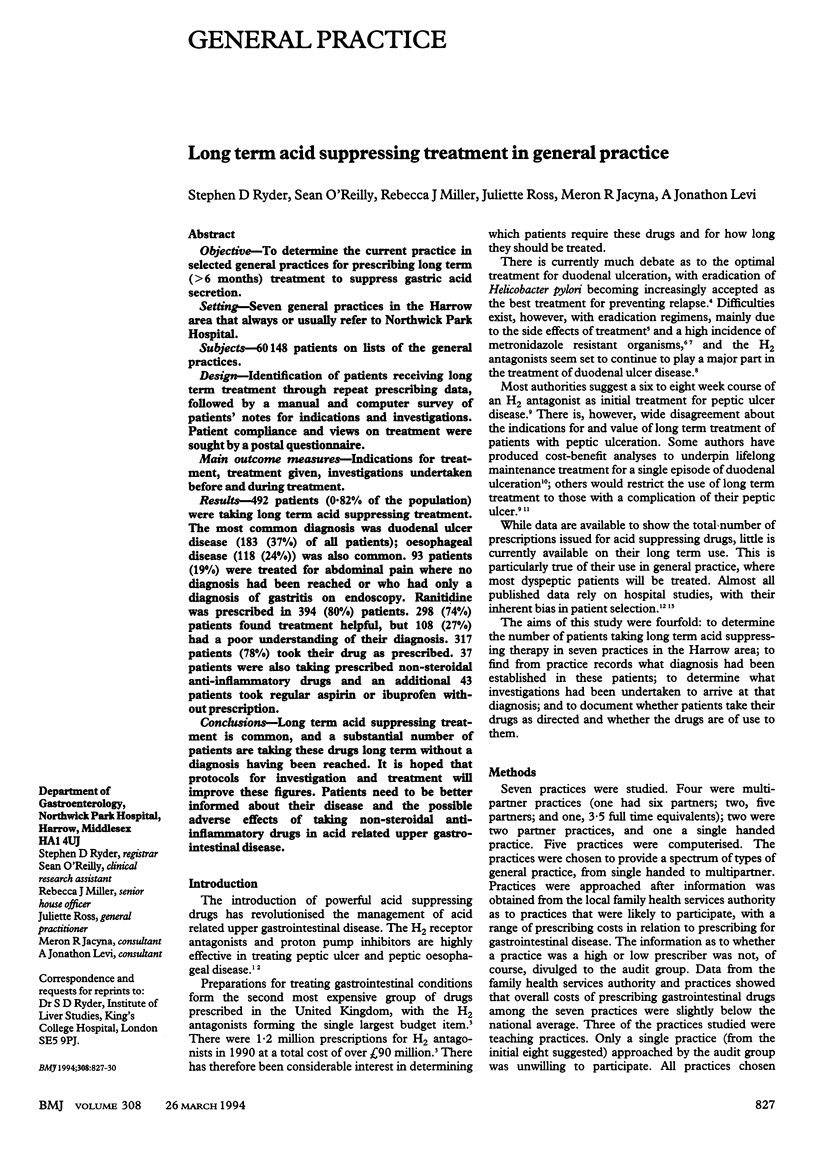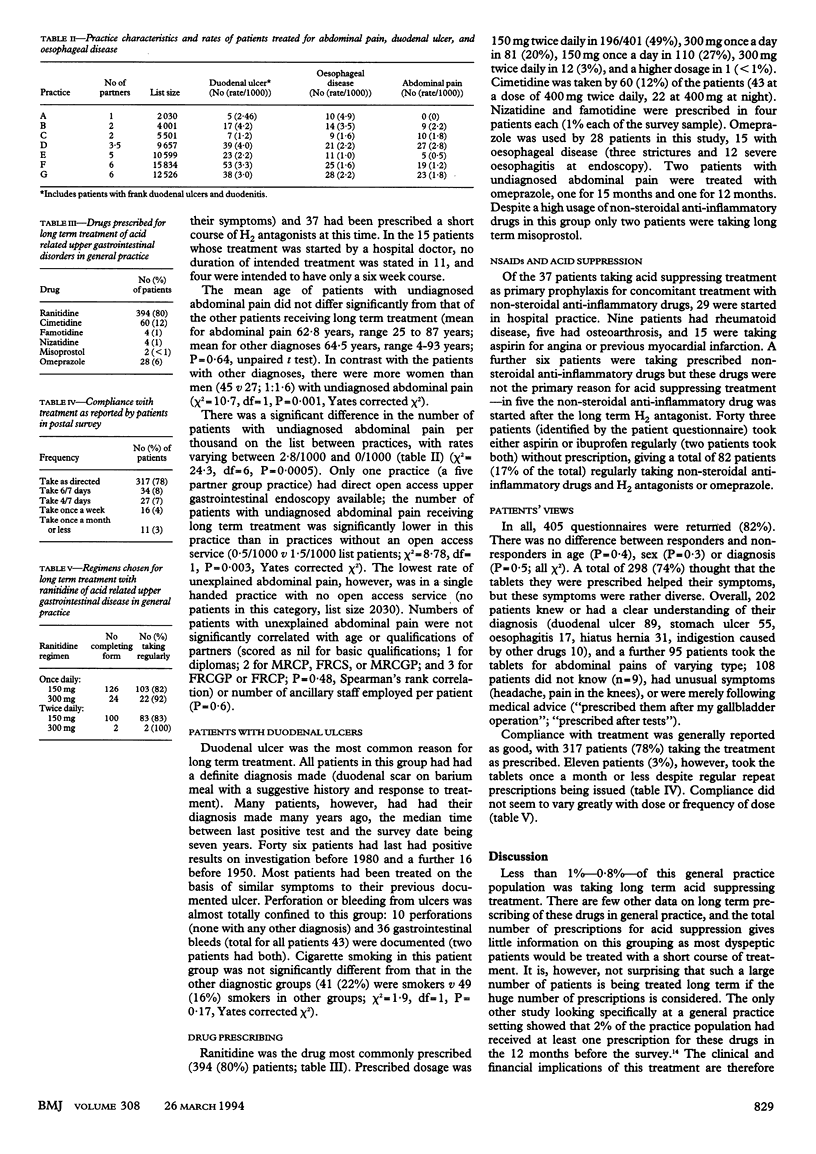Abstract
OBJECTIVE--To determine the current practice in selected general practices for prescribing long term (> 6 months) treatment to suppress gastric acid secretion. SETTING--Seven general practices in the Harrow area that always or usually refer to Northwick Park Hospital. SUBJECTS--60,148 patients on lists of the general practices. DESIGN--Identification of patients receiving long term treatment through repeat prescribing data, followed by a manual and computer survey of patients' notes for indications and investigations. Patient compliance and views on treatment were sought by a postal questionnaire. MAIN OUTCOME MEASURES--Indications for treatment, treatment given, investigations undertaken before and during treatment. RESULTS--492 patients (0.82% of the population) were taking long term acid suppressing treatment. The most common diagnosis was duodenal ulcer disease (183 (37%) of all patients); oesophageal disease (118 (24%)) was also common. 93 patients (19%) were treated for abdominal pain where no diagnosis had been reached or who had only a diagnosis of gastritis on endoscopy. Ranitidine was prescribed in 394 (80%) patients. 298 (74%) patients found treatment helpful, but 108 (27%) had a poor understanding of their diagnosis. 317 patients (78%) took their drug as prescribed. 37 patients were also taking prescribed non-steroidal anti-inflammatory drugs and an additional 43 patients took regular aspirin or ibuprofen without prescription. CONCLUSIONS--Long term acid suppressing treatment is common, and a substantial number of patients are taking these drugs long term without a diagnosis having been reached. It is hoped that protocols for investigation and treatment will improve these figures. Patients need to be better informed about their disease and the possible adverse effects of taking non-steroidal anti-inflammatory drugs in acid related upper gastrointestinal disease.
Full text
PDF



Selected References
These references are in PubMed. This may not be the complete list of references from this article.
- Baum C., Kennedy D. L., Forbes M. B. Utilization of nonsteroidal antiinflammatory drugs. Arthritis Rheum. 1985 Jun;28(6):686–692. doi: 10.1002/art.1780280613. [DOI] [PubMed] [Google Scholar]
- Chiverton S. G., Hunt R. H. Medical regimens in short- and long-term ulcer management. Baillieres Clin Gastroenterol. 1988 Jul;2(3):655–676. doi: 10.1016/s0950-3528(88)80012-5. [DOI] [PubMed] [Google Scholar]
- Cocco A. E., Cocco D. V. A survey of cimetidine prescribing. N Engl J Med. 1981 May 21;304(21):1281–1281. doi: 10.1056/NEJM198105213042108. [DOI] [PubMed] [Google Scholar]
- Dooley C. P. Helicobacter pylori: review of research findings. Aliment Pharmacol Ther. 1991;5 (Suppl 1):129–143. doi: 10.1111/j.1365-2036.1991.tb00756.x. [DOI] [PubMed] [Google Scholar]
- Freston J. W. H2-receptor antagonists and duodenal ulcer recurrence: analysis of efficacy and commentary on safety, costs, and patient selection. Am J Gastroenterol. 1987 Dec;82(12):1242–1249. [PubMed] [Google Scholar]
- Gilliland A. E., Mills K. A., Irwin W. G., Steele K. Patients on H2-receptor antagonists--are we investigating them? Fam Pract. 1990 Mar;7(1):43–46. doi: 10.1093/fampra/7.1.43. [DOI] [PubMed] [Google Scholar]
- Gotthard R., Bodemar G., Brodin U., Jönsson K. A. Treatment with cimetidine, antacid, or placebo in patients with dyspepsia of unknown origin. Scand J Gastroenterol. 1988 Jan;23(1):7–18. doi: 10.3109/00365528809093840. [DOI] [PubMed] [Google Scholar]
- Heatley R. V. Review article: the treatment of Helicobacter pylori infection. Aliment Pharmacol Ther. 1992 Jun;6(3):291–303. doi: 10.1111/j.1365-2036.1992.tb00051.x. [DOI] [PubMed] [Google Scholar]
- Hirschowitz B. I., Berenson M. M., Berkowitz J. M., Bright-Asare P., DeLuca V. A., Jr, Eshelman F. N., Font R. G., Griffin J. W., Jr, Kozarek R. A., McCray R. S. A multicenter study of ranitidine treatment of duodenal ulcers in the United States. J Clin Gastroenterol. 1986 Jun;8(3 Pt 2):359–366. doi: 10.1097/00004836-198606002-00006. [DOI] [PubMed] [Google Scholar]
- Hixson L. J., Kelley C. L., Jones W. N., Tuohy C. D. Current trends in the pharmacotherapy for peptic ulcer disease. Arch Intern Med. 1992 Apr;152(4):726–732. [PubMed] [Google Scholar]
- Johannessen T., Fjøsne U., Kleveland P. M., Halvorsen T., Kristensen P., Løge I., Hafstad P. E., Sandbakken P., Petersen H. Cimetidine responders in non-ulcer dyspepsia. Scand J Gastroenterol. 1988 Apr;23(3):327–336. doi: 10.3109/00365528809093874. [DOI] [PubMed] [Google Scholar]
- Klinkenberg-Knol E. C. The role of omeprazole in healing and prevention of reflux disease. Hepatogastroenterology. 1992 Feb;39 (Suppl 1):27–30. [PubMed] [Google Scholar]
- Lanza F. L., Fakouhi D., Rubin A., Davis R. E., Rack M. F., Nissen C., Geis S. A double-blind placebo-controlled comparison of the efficacy and safety of 50, 100, and 200 micrograms of misoprostol QID in the prevention of ibuprofen-induced gastric and duodenal mucosal lesions and symptoms. Am J Gastroenterol. 1989 Jun;84(6):633–636. [PubMed] [Google Scholar]
- Mendelowitz P. C., Hoffman R. S., Weber S. Bismuth absorption and myoclonic encephalopathy during bismuth subsalicylate therapy. Ann Intern Med. 1990 Jan 15;112(2):140–141. doi: 10.7326/0003-4819-112-2-140. [DOI] [PubMed] [Google Scholar]
- Millar M. R., Pike J. Bactericidal activity of antimicrobial agents against slowly growing Helicobacter pylori. Antimicrob Agents Chemother. 1992 Jan;36(1):185–187. doi: 10.1128/aac.36.1.185. [DOI] [PMC free article] [PubMed] [Google Scholar]
- Nørrelund N., Helles A., Schmiegelow M. Ukarakteristisk dyspepsi i almen praksis. En kontrolleret undersøgelse med et antacidum (Alminox). Ugeskr Laeger. 1980 Jun 30;142(27):1750–1753. [PubMed] [Google Scholar]
- Rautelin H., Seppälä K., Renkonen O. V., Vainio U., Kosunen T. U. Role of metronidazole resistance in therapy of Helicobacter pylori infections. Antimicrob Agents Chemother. 1992 Jan;36(1):163–166. doi: 10.1128/aac.36.1.163. [DOI] [PMC free article] [PubMed] [Google Scholar]
- Saultz J. W. Cimetidine prescribing patterns in a military community hospital. Mil Med. 1985 Jun;150(6):300–302. [PubMed] [Google Scholar]
- Somerville K., Faulkner G., Langman M. Non-steroidal anti-inflammatory drugs and bleeding peptic ulcer. Lancet. 1986 Mar 1;1(8479):462–464. doi: 10.1016/s0140-6736(86)92927-2. [DOI] [PubMed] [Google Scholar]
- Talley N. J., McNeil D., Hayden A., Piper D. W. Randomized, double-blind, placebo-controlled crossover trial of cimetidine and pirenzepine in nonulcer dyspepsia. Gastroenterology. 1986 Jul;91(1):149–156. doi: 10.1016/0016-5085(86)90451-8. [DOI] [PubMed] [Google Scholar]
- Wormsley K. G. Maintenance therapy for peptic ulcer disease. Aliment Pharmacol Ther. 1991;5 (Suppl 1):37–47. doi: 10.1111/j.1365-2036.1991.tb00747.x. [DOI] [PubMed] [Google Scholar]


